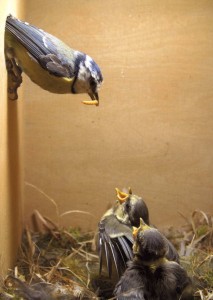 The recent Press Release from CJ Wildlife highlights the fact that the annual “National Nest Box Week” runs from 14th to 21st February. This timely advance notice gives us all the chance to either think of starting to use nestboxes or to re-look at those we already have. It certainly made me suddenly realise that since last year’s very poor breeding season, with a few exceptions, I have not really looked at the large series of nestboxes in the garden and one acre paddock. We still have time to do this and to order new boxes, re-furbish any that need attention, and to decide on the critical factors as to where to put any new ones. The range of nestboxes is now amazing from the largest ones for kestrels and owls to the much smaller ones for the various tits or robins. Then, of course, if you are a handyman, then you can always make your own.
The recent Press Release from CJ Wildlife highlights the fact that the annual “National Nest Box Week” runs from 14th to 21st February. This timely advance notice gives us all the chance to either think of starting to use nestboxes or to re-look at those we already have. It certainly made me suddenly realise that since last year’s very poor breeding season, with a few exceptions, I have not really looked at the large series of nestboxes in the garden and one acre paddock. We still have time to do this and to order new boxes, re-furbish any that need attention, and to decide on the critical factors as to where to put any new ones. The range of nestboxes is now amazing from the largest ones for kestrels and owls to the much smaller ones for the various tits or robins. Then, of course, if you are a handyman, then you can always make your own.
As for guidance over nestboxes, I generally resort to two publications. One is the “bible” for nestboxes, the BTO’s modestly priced “The BTO Nestbox Guide” written by Chris du Feu first published in 2003. Tel. 01842 750050 to purchase a copy. The other source and one I increasingly use is CJ Wildlife’s “Handbook of garden wildlife”. This has the advantage of covering not only birds but nestboxes for other groups such as bats, hedgehogs and insects such as bees and butterflies. This handbook is free so just telephone Freephone 0800 731 2820 and request a Free handbook of garden wildlife. This handbook also covers the great variety of food available for garden birds and other wildlife so is an invaluable guide to wildlife in your garden. They also produce a free newsletter every month keeping readers up with all the latest developments and ideas.
Nestboxes for birds come in all shapes and sizes and in my plot of ground there is a wide variety. One or two have never been used such as the large box in the beech trees for kestrels or barn owls. Even at the other end of the scale there is a special design for tree creeper which is a triangular shaped box. Despite tree creepers being regular visitors to the garden neither of the three boxes for them have ever been used. The other small specialised box that has been successful is the open fronted one that should attract robins, pied wagtails and spotted flycatchers. At various time these have been used by both pied wagtails and spotted flycatchers but not every year by any means.
One aspect I have learnt by experience is the size of the hole in the small, standard shaped box. At one time it was thought that smaller holes would suffice but in reality only blue tits, as shown in the photograph, will get into those smaller ones. The photograph was taken with a special camera inside the nestbox which is a set up you can get for around £100. One of the adult blue tits is bringing in food, a caterpillar, to the begging nestlings in the bottom of the box. Such cameras can be linked up to a television or a computer and is a real eye opener and quite fascinating. If you make the entrance hole larger at 28 mm or more you might just get redstart or pied flycatcher as a bonus. In the nestboxes in my garden we have had pied flycatchers in the past but not in recent years. One year there were two pairs of redstarts in nestboxes which is very unusual here. Then there are more specialised nestboxes such as the artificial house martin boxes and these have been very successful here. There are as many house martins nesting in these as there are where they have built their own nests. It always seems incongruous to me to see a pair of house martins occupying an artificial nestbox with all the advantages it brings whilst another pair is building a nest from scratch. Sometimes the pair building their own nest actually attach it to an artificial box that is in use. Very strange to my way of thinking. For anyone contemplating doing anything for the “National Nest Box Week” I would recommend just telephoning CJWildlife and getting their free handbook.
